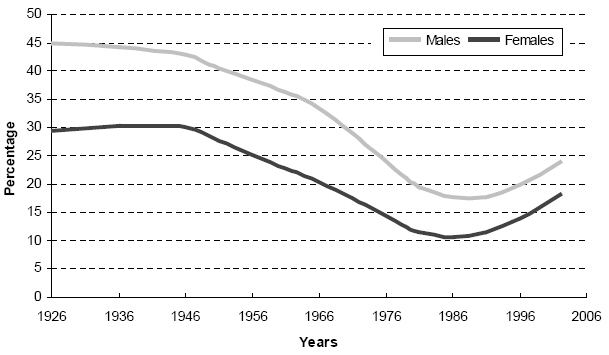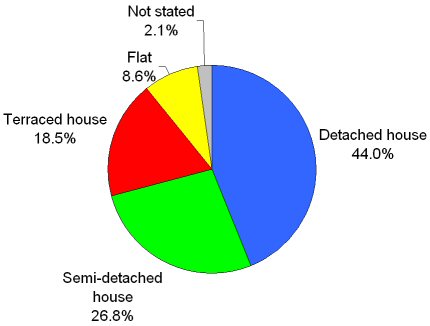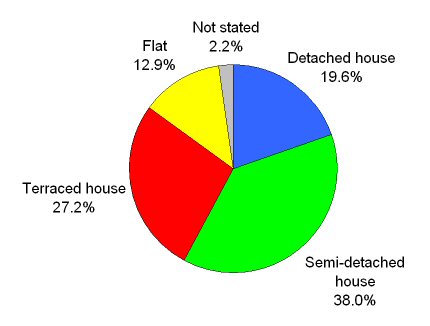
An Overview of the Society in the Republic of Ireland
3. Housing +
Given that over 90 per cent of marriages occur between persons aged under 35 years of age, the proportion of the 35-44 year age group who are single is a good indicator of long-term trends in the population who never marry. The long-term decline since 1926 in the proportion of 35-44 year olds who were single was halted in 1986. The proportion has increased at all censuses since then. This reflects the fact that while the marriage rate increased for most of the period it declined again over the last two decades.
Percentage single aged 35-44 years

The number of separated persons (including
divorced) increased by over a half (50%)
between 1996 and 2002
(![]() 7%, 1990-2001).
The number of persons recorded as
divorced more than trebled, between 1996 and 2002, reflecting to a large extent
the legalisation of divorce being allowed for the first time in the State in
1997!
7%, 1990-2001).
The number of persons recorded as
divorced more than trebled, between 1996 and 2002, reflecting to a large extent
the legalisation of divorce being allowed for the first time in the State in
1997!
Separated and divorced by sex

The average size of private households fell
from 3.14 in 1996 to 2.94 in 2002, thus continuing the long-term decline
(![]() 2.6).
2.6).
|
Number of children in family units |
1981 (%) |
2002 (%) |
|
|
0 |
18 |
25 |
50.2 |
|
1 |
22 |
26 |
27.4 |
|
2 |
21 |
25 |
14.2 |
|
3 |
16 |
14 |
5.5 |
|
4 |
21 |
8 |
2.7 |
Overall, cohabiting
couples accounted for 8.4 per cent
(![]() 9.5%) of
all family units in 2002 compared with 3.9 per cent in 1996. Those without
children accounted for one in five of all childless couples in 2002, while those
with children represented 5.5 per cent of all couples with children.
9.5%) of
all family units in 2002 compared with 3.9 per cent in 1996. Those without
children accounted for one in five of all childless couples in 2002, while those
with children represented 5.5 per cent of all couples with children.
Detached homes were the predominant housing type in 2002, accounting for 44% of all housing. More than four out of five rural dwellings were detached residences while semi-detached and terraced housing were the most common dwelling types in urban areas. Flats and apartments featured strongly in urban areas, making up 13 per cent of urban homes in 2002.
Distribution of dwelling types, 2002
total
urban rural



The number of persons per
room provides a general indicator of housing conditions.
Between 1926 and 2002 the "density" of persons
per room has more than halved, from 1.19 in 1926 to 0.53 in the most recent
census
(![]() 0.97).
0.97).
Over 555,000 (43.5%)
(![]() 8.5%)
households had a personal computer (PC) in
April 2002 while 436,000 (34.1%)
(
8.5%)
households had a personal computer (PC) in
April 2002 while 436,000 (34.1%)
(![]() 6%, 2005: 9%)
had access to the Internet. Urban areas were Internet access ahead
of rural ones in terms of access to both facilities (45.3% compared with 40.6%
for PCs and 35.9% compared with 31.1% for Internet access).
6%, 2005: 9%)
had access to the Internet. Urban areas were Internet access ahead
of rural ones in terms of access to both facilities (45.3% compared with 40.6%
for PCs and 35.9% compared with 31.1% for Internet access).
Car ownership was higher in rural areas (86.2%) than in urban areas (73.3%). The trend in both areas has been sharply upwards since 1991 when the relevant percentages were 74.6 per cent and 59.5 per cent, respectively. Over a million households had at least one car each in 2002 – an increase of 330,000 compared with 1991. When account is taken of the growth in the overall numbers of households in the same period, those without a car declined by 20 per cent.
sources:
Irish Presidency of the EU website
Census 2002 - Principal Socio-Economic Results
credits:
The text was composed by using the relevant materials of...
1.
Census 2002 - Principal Socio-Economic Results © Government of Ireland 2003